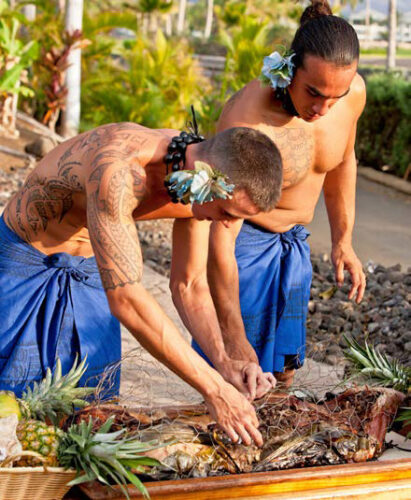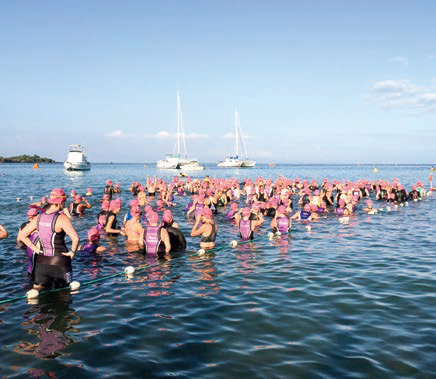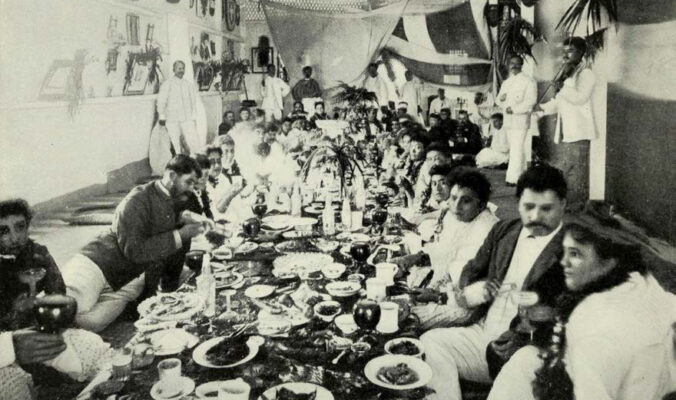The lū`au tradition in Hawai`i began more than 200 years ago. When first introduced by King Kamehameha II in 1819, it represented a complete break from the ancient Hawaiian custom where men and women ate meals separately, and commoners and women of all ranks were forbidden to eat certain delicacies.
To symbolize this break, King Kamehameha II brought men, women and ali`i (royalty) together for a regal feast. The practice evolved and became known as a ‘lū`au,’ named for a traditional local dish made of taro leaves and chicken baked in coconut milk.
One of the most legendary lū`au was King Kamehameha III’s 1847 event, during which more than 4,000 taro plants, 271 pigs, 482 gourds of poi, 2,245 coconuts and 5,000 fish were consumed by attendees in an opulent celebratory feast.
During the mid-20th century tourism boom in Hawai`i, lū`au became popular with visitors. Today, most often hosted at hotels, lū`au can be highly polished productions complete with Polynesian music, chanting and dancing, and bountiful buffets of local dishes. One example of the traditional lū`au that resort guests can experience is found at Waikoloa Beach Marriott Resort & Spa.
“Our Sunset lū`au is rooted in tradition,” says the hotel’s Executive Chef Jayson Kanekoa. “We pride ourselves on providing an authentic lū`au experience that starts with food. The kalua pork is prepared in an imu (underground oven) that goes in the ground in the morning, slow-roasts all day over kiawe (mesquite), then comes out just before sunset. In addition, traditional-style poke and poi, as well as other local comfort foods, headline our menu with a few familiar dishes for guests to savor.”
 Following dinner, the Sunset lū`au presents a Polynesian revue, during which guests enjoy songs and dances from Hawai`i and the Pacific, including the thrilling siva afi — the Samoan fire knife dance.
Following dinner, the Sunset lū`au presents a Polynesian revue, during which guests enjoy songs and dances from Hawai`i and the Pacific, including the thrilling siva afi — the Samoan fire knife dance.
Born and raised near Wāipi`o Valley on the northeastern coast of Hawai`i Island, Kanekoa says his love for cooking was instilled by his late grandfather, a legendary taro farmer, who passed down many family recipes and made his own poi. “It’s great to be able to share the foods I grew up eating with visitors from around the world,” he says.
Husband-and-wife team Papali`itele Jack “Tihati” and Cha Thompson have been producing grand lū`au events throughout the state of Hawai`i and around the world for more than 50 years. Their company, Tihati Productions, began with a modest cast of six in 1969 and flourished into several productions shows, international tours, television appearances and spectacular performances.
Now directed by their children, Afatia Thompson and Misty Tufono, the dance company shares Polynesian culture through the art of song and dance, including the Polynesian Legends of Hawai`i lū`au at Hilton Waikoloa Village, complete with a torch run, a blessing, dinner, musical and hula performances.
“We take tremendous pride in our Hawaiian culture and the proud history of Hawai`i Island,” Afatia explains. “Many of us grew up at home, at parties or any type of gatherings sharing songs and dances. The stories and legends specific to Hawai`i Island and its relationship to the broader Pacific distinguishes Legends of Hawai`i lū`au.”
But not all lū`au are for visitors. In backyards, garages, nearby beaches or parks, smaller, less formal lū`au are held by local families to celebrate special
occasions such as school graduations, weddings, birthdays and the much-loved first birthday, “baby lū`au.” These celebrations often include music performed by friends or family members, and a hula dance by a talented cousin or auntie.
Like at the hotels, local lū`au typically include laulau — food wrapped and steamed in young taro leaves — and poi. Fresh poke, roasted pork and lomi lomi salmon are also popular, in addition to dishes that reflect the multicultural nature of Hawai`i such as Chinese noodles, Korean barbecue beef and malasadas, the renowned Portuguese doughnuts.
But whether big and public or a smaller family gathering, lū`au continue to be unifying experiences, as King Kamehameha II intended. They are a place where friends and family come together to celebrate Polynesian culture and the gift of life.
2024 Lavaman Triathlon
 The Lavaman Triathlon will be held on April 7 at Waikoloa Beach Resort, beginning with a 1500-meter swim at Anaeho’omalu Bay. On this 25th anniversary, a duathlon option will also be offered. In lieu of the swim, Duathletes will run an out-and-back 3.1k on Waikoloa Beach Drive starting and finishing at transition. The triathlon begins at 7 am and officially concludes at 2 pm. Nearly 2,000 athletes will compete.
The Lavaman Triathlon will be held on April 7 at Waikoloa Beach Resort, beginning with a 1500-meter swim at Anaeho’omalu Bay. On this 25th anniversary, a duathlon option will also be offered. In lieu of the swim, Duathletes will run an out-and-back 3.1k on Waikoloa Beach Drive starting and finishing at transition. The triathlon begins at 7 am and officially concludes at 2 pm. Nearly 2,000 athletes will compete.
Cultural Walking App
 For visitors seeking a deeper understanding of the vibrant culture and significant preservation sites that shaped this land, a historic walking tour around Waikoloa Beach Resort just got easier. A new app, which can easily be downloaded from your app store, acts as an interactive guide with narratives along the ancient trail. Cultural tour guides share stories and insights about Hawaiian culture, with stops at sacred temples, petroglyphs, royal fishponds and more.
For visitors seeking a deeper understanding of the vibrant culture and significant preservation sites that shaped this land, a historic walking tour around Waikoloa Beach Resort just got easier. A new app, which can easily be downloaded from your app store, acts as an interactive guide with narratives along the ancient trail. Cultural tour guides share stories and insights about Hawaiian culture, with stops at sacred temples, petroglyphs, royal fishponds and more.
Lavaka Gallery Brings Polynesian Masterpieces to Kings’ Shops
 Fetuufoou Lavaka began learning skill firsthand.” Ardent art collectors, the Florys traditional Tongan wood carving at the age of eight from his father, who was also taught by his father. Like in Hawai`i, carving is an important part of the Tongan culture where skilled carvers created functional pieces such as canoes, tools and weapons.
Fetuufoou Lavaka began learning skill firsthand.” Ardent art collectors, the Florys traditional Tongan wood carving at the age of eight from his father, who was also taught by his father. Like in Hawai`i, carving is an important part of the Tongan culture where skilled carvers created functional pieces such as canoes, tools and weapons.
Today a master carver, Fetu’s works can be found at Lavaka Gallery — the only fine art gallery dedicated solely to Polynesian wood carving in Hawai`i. Since opening at the Kings’ Shops in December, the new store features whales’ tales, manta rays, honu (turtles) and tiki made solely by Fetu and his family members.
“(We) come from the island of Tongan, where we have been carving for four generations,” he says. “Carving has always been a part of my family.”
Lavaka Gallery’s director, Arianna Flory, says she and her family were “blown away when they met Fetu five years ago and saw his tiki carvings and from there developed a close friendship. This past summer, after Lavaka’s studio in Lahaina was destroyed by the fire, both families decided to collaborate on the new space.
Most works at Lavaka Gallery are made from locally sourced koa and monkeypod woods. “All of them represent my love for the land, earth and sea through their depictions of gods, sea life and symbolic geometric patterns,” Fetu explains. “The ones that speak to me the most depict Tongan gods, like Limu, and are symbols of protection.”
Utilizing the core of a koa tree to carve a tiki takes hours and hours of craftsmanship. At Lavaka Gallery they range from 18 inches to eight feet tall.
“We’ve had commissions for hotels and private clients up to 20 feet or taller too,” Arianna says. “We’ve been getting a great response from the community.”

